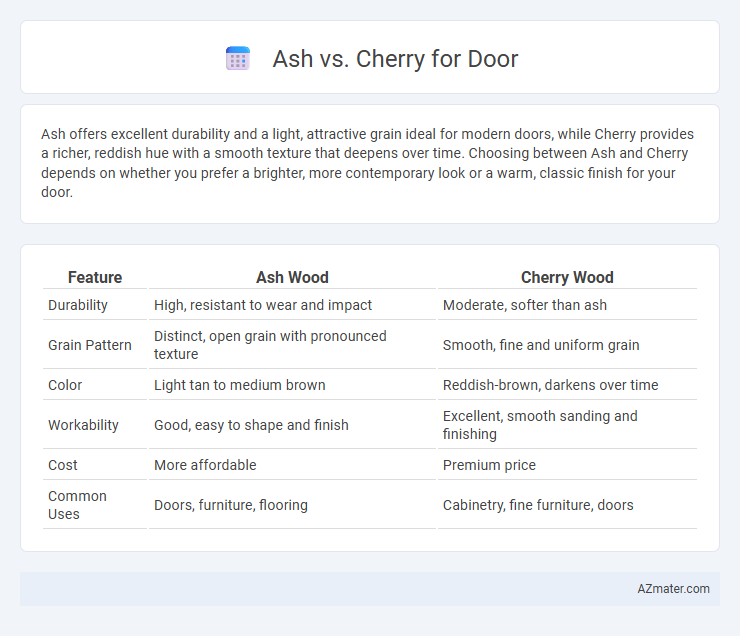Ash offers excellent durability and a light, attractive grain ideal for modern doors, while Cherry provides a richer, reddish hue with a smooth texture that deepens over time. Choosing between Ash and Cherry depends on whether you prefer a brighter, more contemporary look or a warm, classic finish for your door.
Table of Comparison
| Feature | Ash Wood | Cherry Wood |
|---|---|---|
| Durability | High, resistant to wear and impact | Moderate, softer than ash |
| Grain Pattern | Distinct, open grain with pronounced texture | Smooth, fine and uniform grain |
| Color | Light tan to medium brown | Reddish-brown, darkens over time |
| Workability | Good, easy to shape and finish | Excellent, smooth sanding and finishing |
| Cost | More affordable | Premium price |
| Common Uses | Doors, furniture, flooring | Cabinetry, fine furniture, doors |
Introduction to Ash and Cherry Wood for Doors
Ash wood, valued for its strength, straight grain, and light color, offers durability and bright aesthetics ideal for door construction. Cherry wood, known for its smooth texture, rich reddish-brown hue, and natural aging process, provides an elegant and warm appearance for interior doors. Both woods balance functionality and beauty, with ash emphasizing robustness and cherry highlighting refined design.
Ash vs Cherry: Appearance and Color Differences
Ash wood features a light, creamy white to pale brown color with a straight, pronounced grain pattern that gives doors a bright and natural appearance. In contrast, Cherry wood displays a warm, rich reddish-brown hue that darkens with age, offering doors a sophisticated and elegant look. The color stability and grain texture differences make Ash ideal for contemporary designs, while Cherry suits traditional or formal door styles.
Grain Patterns: Ash vs Cherry Wood
Ash wood features a pronounced, straight grain pattern with distinct growth rings that enhance its natural texture and provide a bright, airy appearance suitable for doors needing strong visual impact. Cherry wood exhibits a smoother, fine grain with subtle swirls and occasional small knots, offering a rich, warm tone that deepens over time, ideal for elegant and classic door designs. The contrasting grain patterns between Ash and Cherry not only influence aesthetics but also help determine the door's style suitability and maintenance requirements.
Durability and Hardness Comparison
Ash wood offers excellent durability with a Janka hardness rating of approximately 1,320, making it resistant to dents and wear, suitable for high-traffic doors. Cherry wood, while prized for its rich color and smooth grain, has a lower Janka hardness of around 950, resulting in moderate durability but greater susceptibility to scratches and dents. Choosing ash over cherry for doors enhances longevity and structural integrity, especially in areas prone to frequent use or impact.
Cost Analysis: Ash Doors vs Cherry Doors
Ash doors typically cost less than cherry doors, making them a budget-friendly option for interior and exterior applications. While ash wood has a lighter color and more open grain, cherry offers a rich, warm hue with smoother texture, which contributes to its higher price point. Choosing between ash and cherry doors involves balancing initial expense against aesthetic preference and long-term durability.
Workability and Finishing Properties
Ash wood offers excellent workability with its straight grain and coarse texture, making it easy to cut, shape, and sand for door construction. It absorbs finishes evenly, resulting in a smooth surface that enhances its natural light color and prominent grain patterns. Cherry wood, known for its fine, smooth grain, machines well and takes stain and polish beautifully, producing a rich, warm reddish tone with a high-quality, durable finish ideal for elegant door applications.
Resistance to Moisture and Warping
Ash offers excellent resistance to moisture, making it less prone to warping in humid environments compared to cherry wood. Cherry wood, while durable and aesthetically appealing, tends to absorb moisture more readily, increasing the risk of swelling and warping over time. For door applications in moist conditions, ash is a superior choice due to its stability and resilience against moisture-related deformation.
Maintenance Requirements for Ash vs Cherry Doors
Ash doors require regular sealing and occasional sanding to maintain their durability and resist moisture damage, making them relatively easy to maintain with proper care. Cherry doors, known for their rich color and fine grain, demand consistent polishing and protection from direct sunlight to prevent fading and discoloration over time. Both wood types benefit from controlled indoor humidity and cleaning with gentle, wood-safe products to preserve their appearance and structural integrity.
Environmental Impact and Sustainability
Ash wood offers a strong, durable option for doors with a moderate environmental impact due to its fast growth and wide availability in North America, promoting sustainable harvesting practices. Cherry wood, while prized for its rich color and fine grain, grows slower and is less abundant, leading to concerns over deforestation and higher environmental costs. Choosing ash supports sustainability through faster replenishment cycles, whereas cherry demands careful sourcing from certified forests to minimize ecological footprint.
Which Is Better: Ash or Cherry for Your Door?
Ash offers superior durability and a pronounced grain pattern, making it ideal for high-traffic doors requiring strength and visual texture. Cherry wood provides a smooth finish and rich, warm tones that deepen over time, lending a luxurious and elegant appearance to interior doors. Choosing between ash and cherry depends on desired aesthetics and durability needs, with ash favored for toughness and cherry prized for its sophisticated color and smoothness.

Infographic: Ash vs Cherry for Door
 azmater.com
azmater.com